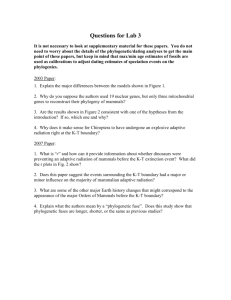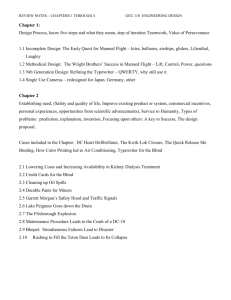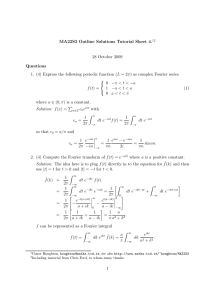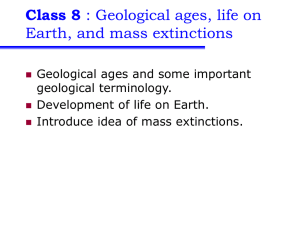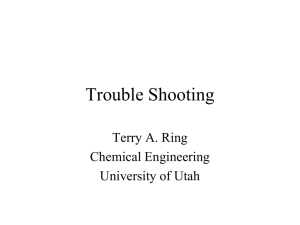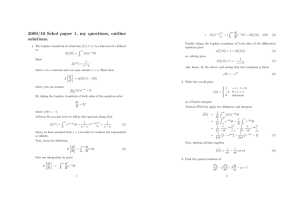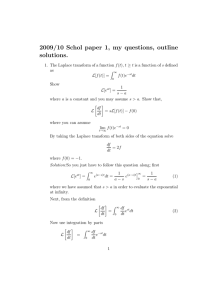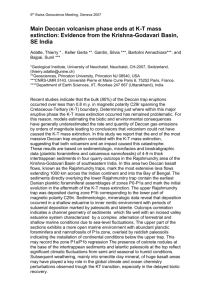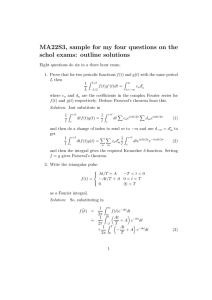Teacher Materials
advertisement
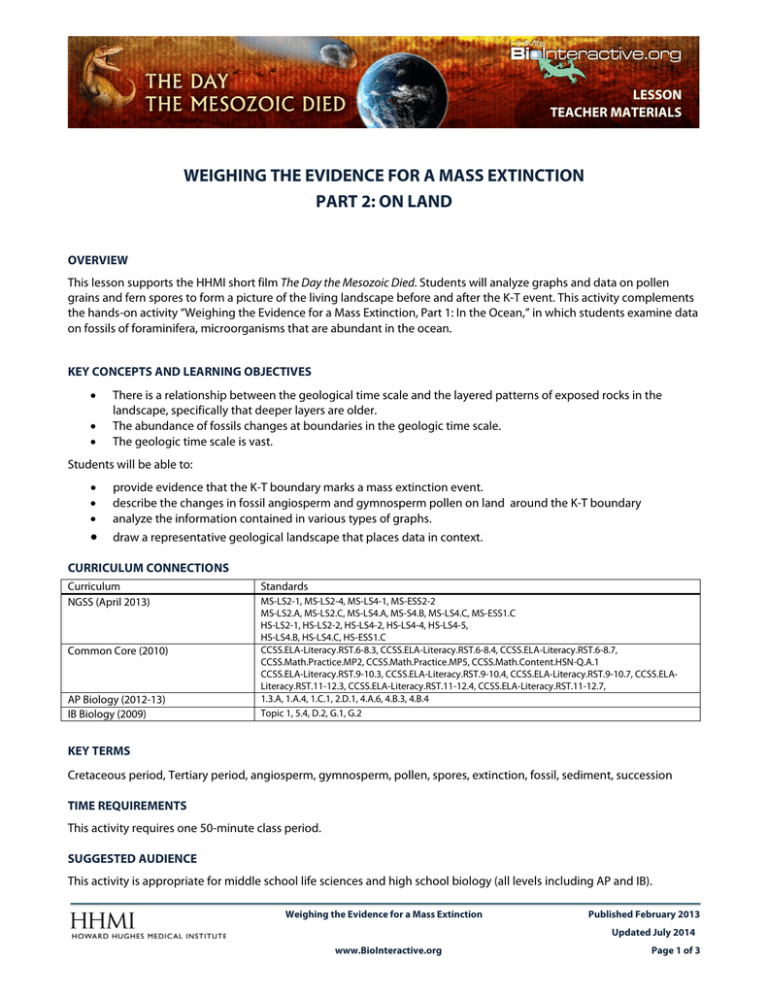
LESSON TEACHER MATERIALS WEIGHING THE EVIDENCE FOR A MASS EXTINCTION PART 2: ON LAND OVERVIEW This lesson supports the HHMI short film The Day the Mesozoic Died. Students will analyze graphs and data on pollen grains and fern spores to form a picture of the living landscape before and after the K-T event. This activity complements the hands-on activity “Weighing the Evidence for a Mass Extinction, Part 1: In the Ocean,” in which students examine data on fossils of foraminifera, microorganisms that are abundant in the ocean. KEY CONCEPTS AND LEARNING OBJECTIVES • • • There is a relationship between the geological time scale and the layered patterns of exposed rocks in the landscape, specifically that deeper layers are older. The abundance of fossils changes at boundaries in the geologic time scale. The geologic time scale is vast. Students will be able to: • • • • provide evidence that the K-T boundary marks a mass extinction event. describe the changes in fossil angiosperm and gymnosperm pollen on land around the K-T boundary analyze the information contained in various types of graphs. draw a representative geological landscape that places data in context. CURRICULUM CONNECTIONS Curriculum NGSS (April 2013) Common Core (2010) AP Biology (2012-13) IB Biology (2009) Standards MS-LS2-1, MS-LS2-4, MS-LS4-1, MS-ESS2-2 MS-LS2.A, MS-LS2.C, MS-LS4.A, MS-S4.B, MS-LS4.C, MS-ESS1.C HS-LS2-1, HS-LS2-2, HS-LS4-2, HS-LS4-4, HS-LS4-5, HS-LS4.B, HS-LS4.C, HS-ESS1.C CCSS.ELA-Literacy.RST.6-8.3, CCSS.ELA-Literacy.RST.6-8.4, CCSS.ELA-Literacy.RST.6-8.7, CCSS.Math.Practice.MP2, CCSS.Math.Practice.MP5, CCSS.Math.Content.HSN-Q.A.1 CCSS.ELA-Literacy.RST.9-10.3, CCSS.ELA-Literacy.RST.9-10.4, CCSS.ELA-Literacy.RST.9-10.7, CCSS.ELALiteracy.RST.11-12.3, CCSS.ELA-Literacy.RST.11-12.4, CCSS.ELA-Literacy.RST.11-12.7, 1.3.A, 1.A.4, 1.C.1, 2.D.1, 4.A.6, 4.B.3, 4.B.4 Topic 1, 5.4, D.2, G.1, G.2 KEY TERMS Cretaceous period, Tertiary period, angiosperm, gymnosperm, pollen, spores, extinction, fossil, sediment, succession TIME REQUIREMENTS This activity requires one 50-minute class period. SUGGESTED AUDIENCE This activity is appropriate for middle school life sciences and high school biology (all levels including AP and IB). Weighing the Evidence for a Mass Extinction Published February 2013 Updated July 2014 www.BioInteractive.org Page 1 of 3 LESSON TEACHER MATERIALS PRIOR KNOWLEDGE Students should know what a fossil is and understand that older fossils are found in deeper rock layers than younger fossils. Fossils provide information about which organisms existed at different times. Students should also be aware of Earth’s geological time scale and that it is used to analyze the timing of and relationships between past events. MATERIALS Students will need the student version of this activity. TEACHING TIPS • Before doing this activity, you may want your students to complete “Weighing the Evidence for a Mass Extinction, Part 1: In the Ocean.” In that hands-on activity, students will examine the evidence for a mass extinction based on fossils found in rocks that lay on the ocean floor 66 million years ago. • Hang a poster showing the geologic time scale in your classroom and point it out to your students so that they can refer to it during the activity. • If you did not already do the “Weighing the Evidence for a Mass Extinction, Part 1: In the Ocean” activity, it might be useful to provide students with some basic information about the geologic time scale. • Students may notice that the Tertiary period is not found on more recent geologic time scales. In 1989, the International Union of Geological Sciences (IUGS) renamed the interval between the Cretaceous and the Quaternary periods as the Paleogene (Pg) and Neogene periods. As a result, recent papers refer to the K-T boundary as the K-Pg boundary. In this activity, we refer to it as the K-T boundary, as that was the term used when the asteroid-impact hypothesis was proposed. • You may want to discuss recovery after a mass extinction. Ecological disruptions, such as volcanic eruptions, wildfires, or asteroid impacts, cause vegetation to be stripped away. A consistent pattern of recovery has been observed. Ferns and other opportunistic plants typically take over the landscape initially. After some time, as conditions improve, ferns decline, giving way to an increasing number of gymnosperms and angiosperms. Gymnosperms and angiosperms that survived the ecological disruption increase in numbers. As conditions continue to improve, these organisms start to diversify, giving rise to new species. • Discuss with students that new species that arise after a mass extinction event are descendants of species that survived the event. ANSWER KEY 1. What happens to the abundance of angiosperm and gymnosperm fossils at the K-T boundary? Both decrease dramatically. 2. What happens to the abundance of angiosperm and gymnosperm fossils after the K-T boundary? The percentage of angiosperms remains low, below levels seen before the K-T boundary. There is also a decrease in the percent abundance of gymnosperm pollen present right around the K-T boundary and a variable but slight increase after the K-T boundary. 3. What is the percent composition of fern spore 1 in the sediment of the Cretaceous period? You may write a range. Between 5% and 15% 4. What is the percent composition of fern spore 2 in the sediment of the Cretaceous period? Close to 0% 5. Describe what happens to the abundance of fern spore fossils in rock layers right above the K-T boundary. Fern spores1 and 2 increase in abundance after the K-T boundary. Weighing the Evidence for a Mass Extinction www.BioInteractive.org Updated July 2014 Page 2 of 3 LESSON TEACHER MATERIALS 6. Compare the fern spore data to the angiosperm and gymnosperm data. The abundance of angiosperms and gymnosperms was high before the K-T boundary and decreased after. There was a dramatic increase in fern spore counts after the K-T event. 7. Which phase has the most leaf diversity? Phase 1 8. Which phase has the least leaf diversity? Phase 2 9. Based on what you learned in Part 1 of this activity, which plant species do you think would be the most prevalent immediately after the K-T event? Ferns are the plant species most prevalent after the K-T event. The graphs in Part 1 of the activity showed that the ratio of fern fossils to those of angiosperms and gymnosperms increased right after the K-T event. 10. Does leaf diversity increase or decrease between phase 2 and 3? What about in subsequent phases? After phase 2, leaf diversity increases with each subsequent phase, although it never reaches the same level of diversity as in phase 1. 11. Describe the overall picture of changes in plants throughout the 2-million-year period represented in Figure 3 and in the graphs in Part 1. Be sure to include the following words in your answer: extinction, recovery, Cretaceous, millions of years. During the Cretaceous period, there were many species of plants, including palm trees and flowering plants. Many species disappeared immediately after the K-T boundary, which marks the timing of the asteroid impact. Immediately after the K-T event, ferns were the dominant form of vegetation on the planet. After the initial fern spike, angiosperms and gymnosperms gradually increased in number and diversity. About 1.5 million years after the K-T event, there are once again many plant species, although not as many as there were in the Cretaceous period. 12. In the boxes below, draw pictures representing the flora you might have seen right before the K-T event and right after the K-T event. Before the K-T event, student pictures should have more angiosperm and gymnosperm plants than ferns. They should draw a variety of plants, including palm trees and some flowering plants. After the K-T event, student pictures should have almost all, if not all, ferns. They might also show a more barren landscape. AUTHORS Written by Mary Colvard,Cobleskill-Richmondville High School (retired) Edited by Laura Bonetta, PhD, and Eriko Clements, PhD, HHMI; Susan Dodge, editorial consultant Reviewed by Vivi Vajda, PhD, Lund University, Sweden Copyedited by Linda Felaco FIELD TESTERS Moira Chadzutko, St. John The Baptist Diocesan High School; Linda Ciota, St John the Baptist Diocesan High School Weighing the Evidence for a Mass Extinction www.BioInteractive.org Updated July 2014 Page 3 of 3
